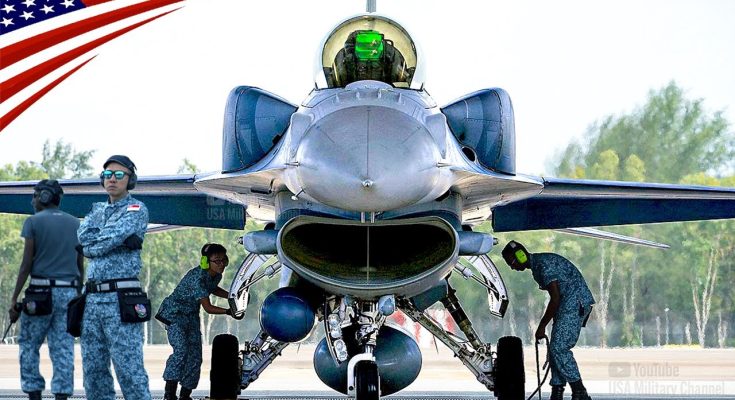The collaboration between Singapore, Taiwan, and the United States in training on advanced F-15 and F-16 fighter jets in dedicated U.S. Air Force squadrons highlights the strengthening of defense partnerships in the Indo-Pacific region. This cooperation is particularly crucial as tensions in the region—especially with China—continue to rise. By training on these advanced aircraft, both Singapore and Taiwan enhance their air combat capabilities and readiness while simultaneously bolstering regional security. The U.S. Air Force, in turn, plays a vital role in providing expertise, resources, and operational experience in these joint exercises.
The Role of Advanced Fighter Jets: F-15s and F-16s
The F-15 and F-16 are two of the most formidable and widely used fighter aircraft in the world, known for their versatility, speed, and combat effectiveness. Both aircraft have undergone continuous upgrades over the years to meet modern combat needs, with advanced avionics, weapons systems, and improved stealth features.
- F-15: The F-15 is primarily designed for air superiority, capable of engaging enemy aircraft at long ranges and with superior maneuverability. It also has an impressive payload capacity, allowing it to carry a wide variety of weapons, including air-to-air missiles, bombs, and precision-guided munitions. The F-15 has been updated into different versions, such as the F-15E, which is capable of both air-to-air and air-to-ground missions. This makes it an ideal platform for combat training in a variety of scenarios.
- F-16: The F-16, a multi-role fighter, is known for its agility, high speed, and operational flexibility. It has been used for both air superiority missions and ground attack roles, making it a versatile asset in any air force. The F-16’s advanced avionics and weapons systems allow it to perform complex missions with great precision, including combat air patrols, strike missions, and close air support.
Both of these fighter jets are critical to the defense strategies of Singapore and Taiwan, given their advanced capabilities and the potential threats posed by nearby regional powers.
The U.S. Air Force’s Role in Training
U.S. Air Force squadrons have long been a cornerstone of international defense cooperation. For Singapore and Taiwan, the opportunity to train with the U.S. Air Force on advanced aircraft like the F-15 and F-16 offers several benefits:
- Expertise and Knowledge Transfer: The U.S. Air Force brings decades of operational experience and advanced technical expertise to the training process. This includes simulated combat scenarios, tactical formations, mission planning, and integrated operations with other military assets, all of which enhance the combat readiness of the Singaporean and Taiwanese pilots.
- Interoperability: One of the key advantages of this training is improving interoperability between the air forces of these nations and the United States. By training together in U.S. Air Force squadrons, pilots from Singapore, Taiwan, and the U.S. develop the ability to communicate effectively, execute joint missions, and operate seamlessly alongside one another in future operations.
- Tactical Coordination: Joint training exercises provide real-world practice in responding to evolving threats, refining tactics, and testing the limits of advanced weaponry and technologies. Through combined drills, aircrews from all three countries learn how to coordinate air combat and precision strikes, as well as refine defensive strategies in high-intensity engagements.
- Realistic Combat Scenarios: U.S. squadrons are equipped with some of the most sophisticated simulation systems available, providing pilots with realistic combat training under various conditions. These scenarios cover everything from dogfights and air-to-ground strikes to intercepting hostile aircraft and executing coordinated strike missions against high-value targets.
Strengthening Security in the Indo-Pacific
The Indo-Pacific is a region of increasing strategic importance, with nations like China expanding their military presence, especially in the South China Sea and near Taiwan. For Singapore, Taiwan, and the United States, working together through training exercises provides a strong deterrent against aggression and demonstrates a shared commitment to regional security.
- Taiwan: Taiwan’s air force has long relied on U.S. aircraft like the F-16 for defense, particularly given the increasing threat posed by China’s growing military might. With the Chinese government frequently challenging Taiwan’s sovereignty, strengthening Taiwan’s ability to defend itself through advanced training and joint exercises is essential. Training on the F-15 and F-16 enhances Taiwan’s combat capabilities and ensures that it is prepared for any potential confrontation.
- Singapore: Singapore, strategically located in the heart of the Indo-Pacific, has a robust and modern air force that plays a key role in regional defense. The city-state’s participation in joint exercises with the U.S. and Taiwan on advanced fighter jets enhances its ability to defend its airspace, support allied forces, and contribute to collective regional security efforts.
Future of Trilateral Cooperation
The training programs with the U.S. Air Force are just one facet of the growing trilateral defense cooperation between the United States, Singapore, and Taiwan. Moving forward, this collaboration will likely deepen, as the three nations explore even more joint military exercises and integrate advanced technologies into their defense strategies.
Additionally, as both Singapore and Taiwan continue to invest in upgrading their air forces with newer variants of the F-16 and other advanced aircraft, the U.S. will continue to be a key partner in training and operational support. This collaboration will likely extend beyond air combat, as the nations work together to develop cybersecurity measures, advanced missile defense systems, and intelligence-sharing initiatives.
In conclusion, the training of Singaporean and Taiwanese pilots on advanced F-15 and F-16 fighter jets in dedicated U.S. Air Force squadrons strengthens the defense capabilities of all three nations. This cooperation enhances regional security, builds interoperability, and sends a clear message of unity in countering threats in the Indo-Pacific region.



